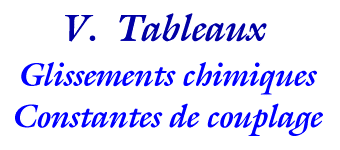



|
ortho |
méta |
para | |
| -NO2 a | 0,92 | 0,25 | 0,38 |
| -COOH a | 0,85 | 0,18 | 0,35 |
| -COOCH2CH3 a | 0,78 | 0,14 | 0,25 |
| -COCH3 a | 0,60 | 0,27 | 0,37 |
| -CHO c | 0,58 | 0,21 | 0,27 |
| -CN a | 0,34 | 0,17 | 0,28 |
| -I b | 0,37 | -0,24 | -0,02 |
| -Br b | 0,17 | -0,10 | -0,06 |
| -Cl b | 0,01 | -0,04 | -0,09 |
| -CH3 a | -0,21 | -0,13 | -0,23 |
| -OCOCH3 c | -0,21 | -0,02 | -0,13 |
| -OCH3 b | -0,39 | -0,01 | -0,35 |
| -OH b | -0,43 | -0,03 | -0,34 |
| -NH2 b | -0,63 | -0,15 | -0,54 |
| a SDBSWeb: SDBS (18 juin
2000) b SDBSWeb: SDBS (21 juin 2000) c Lambert, Joseph B., Shurvell, Herbert F., Lightner, David A., Cooks, R. Graham, Organic Structural Spectroscopy, Prentice-Hall, 1998, Upper Saddle River, New Jersey, page 46. | |||
 Par exemple le groupement nitro du nitrobenzène a un effet inductif
ainsi que mésomère négatif donc attracteur d'électrons. Il appauvrit les
positions ortho et para en électrons et ainsi déblinde les protons fixés sur les
carbones en ces positions. Il n'est donc pas étonnant de voir le proton en ortho
résoner à 7,27 + 0,92 (voir tableau) ou 8,19 d. Le proton en para se retrouve à 7,27 + 0,38
= 7,65 d. Le proton en méta
est beaucoup moins déblindé, phénomène qui s'explique par les formes de
résonance.
Par exemple le groupement nitro du nitrobenzène a un effet inductif
ainsi que mésomère négatif donc attracteur d'électrons. Il appauvrit les
positions ortho et para en électrons et ainsi déblinde les protons fixés sur les
carbones en ces positions. Il n'est donc pas étonnant de voir le proton en ortho
résoner à 7,27 + 0,92 (voir tableau) ou 8,19 d. Le proton en para se retrouve à 7,27 + 0,38
= 7,65 d. Le proton en méta
est beaucoup moins déblindé, phénomène qui s'explique par les formes de
résonance. 
 Le groupement amine de l'aniline a un un effet
mésomère positif donc donneur d'électrons. Il enrichit les positions ortho et
para en électrons et ainsi blinde les protons fixés sur les carbones en ces
positions. C'est pour cette raison que le proton en ortho résone à 7,27 -
0,63 (voir tableau) ou 6,64 d. Le proton en para se retrouve à 7,27 - 0,54 = 6,73 d.
Le groupement amine de l'aniline a un un effet
mésomère positif donc donneur d'électrons. Il enrichit les positions ortho et
para en électrons et ainsi blinde les protons fixés sur les carbones en ces
positions. C'est pour cette raison que le proton en ortho résone à 7,27 -
0,63 (voir tableau) ou 6,64 d. Le proton en para se retrouve à 7,27 - 0,54 = 6,73 d. 


